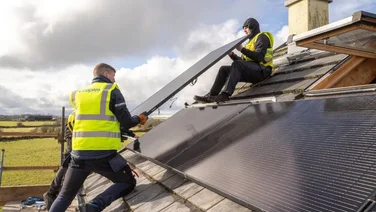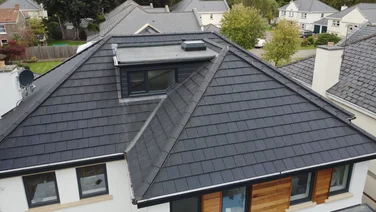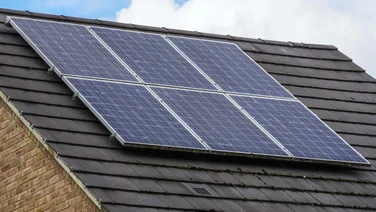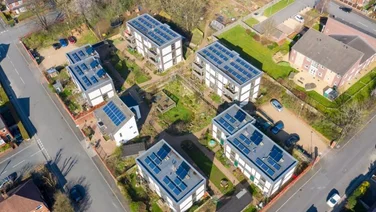- How heavy are solar panels?
- What makes solar panels weigh so much?
- Can solar panels ever be too heavy for a roof?
- Can snow on solar panels increase the strain on your roof?
- How do you know if your roof can support solar panels?
- Can solar panels damage your roof?
- What are the alternatives if solar panels are too heavy for your roof?
- Next steps
- Most solar panels weigh about 40 pounds (18 kilograms)
- Most roofs can support solar panels if they are in good condition
- Ground-mounted panels or thin-film are possible alternatives to rooftop solar
Solar panels are becoming increasingly popular among households across the UK, which is hardly surprising, given they can reduce the amount you spend on energy bills and will actually add value to your property.
However, an understandable concern among those thinking of installing a rooftop solar system is whether or not their roof can support the weight of the solar panels. Here, we explain the main factors involved and what you need to consider.
If you want to find out whether your roof might be suitable for a solar panel system, just enter a few details in our short form, and we’ll put you in touch with expert installers who will be able to provide more detailed advice.

How heavy are solar panels?
Most of the solar panels available on the market, consisting of 60 cells per panel, weigh about 40 pounds (18 kilograms). However, some solar panels can weigh up to 50 pounds (22.6 kilograms), but these are usually produced for the commercial sector rather than for households.
The most common type of solar panels are monocrystalline solar panels, made from wafers cut from single crystals. These panels are more expensive than polycrystalline panels, and are generally smaller, which means they occupy less roof space. They weigh around 30-40 pounds (13-18 kilograms).
Polycrystalline panels are cheaper than monocrystalline panels, but they are not as energy efficient. They usually weigh around 42 pounds (20 kilograms).
The cheapest option are amorphous (thin-film) panels. These weigh a lot less than monocrystalline and polycrystalline panels at around 15 pounds (6 kilograms) per panel. Although they are larger, they are a lot less efficient than other types of solar panel.
How much weight do they add to your roof?
Solar panels weighing about 40 pounds will add about 2.8 pounds (1.27 kilograms) per square foot, while on flat roofs they add about 5 pounds (2.26 kilograms) per square foot.
This can add up when you consider the average home will need at least 10 solar panels on its roof. Find out more about this on our page: How Many Solar Panels Do I Need For My Home?
What makes solar panels weigh so much?
The weight of solar panels is down to the weight of their various components. Of these, the glass is the heaviest item, the other components being the aluminium frame, encapsulation foil, solar cells and the junction box.
Can solar panels ever be too heavy for a roof?
Most roofs can support solar panels, but some can’t, for a variety of reasons. Some brands of solar panels can be fairly heavy and an older roof in poor condition may need reinforcing in order to support them.
Other roofs might need to be repaired first before a solar panel system is installed and some roofs may be suffering from structural damage caused by settling of the building foundations.
Wind damage or leaks that haven’t been repaired may be additional factors, and if this structural damage is extensive, this might entail the replacement of the roof before a solar panel system can be installed upon it.
Some roofs are just old, such that there are only a few more years left before the roof’s serviceable life is spent. Also, solar panel systems are not suitable for wooden roofs because of potential fire hazards.
Can snow on solar panels increase the strain on your roof?
Structural engineers employed by solar panel installers generally consider the average snowfall amounts in a particular region when making their initial inspection. In general, a solar panel system, and the roof that supports it, will not be adversely affected by snowfall except in extreme cases.
This is because solar panels are given a pressure rating that measures the amount of pressure the panels can sustain. Most panels are rated to around 5,000 or more Pascals (Pa). This allows for the weight incurred by two to four feet of snow.
How do you know if your roof can support solar panels?
Most domestic roofs can easily support the weight of a standard solar panel system. However, a good installer would be able to determine this on their initial inspection and, if necessary, undertake any work that is needed to strengthen the roof.

Can solar panels damage your roof?
If your roof is in good condition and the solar panels are installed correctly, then, no, solar panels absolutely will not damage your roof. It is of course important to use the right provider for solar panel roof installation, who needs to be licenced and qualified. The installers will fix the panels on to a roof using roof anchors (also sometimes called roof hooks or brackets), mounting rails and clamps.
The mounting rails are made from aluminium to reduce the weight, while other components are also made from aluminium or stainless steel. This is how the solar panel system is attached to the roof timbers. Slate-tiled roofs can be more difficult, but on roofs with clay tiles, there should be no need for drilling.
What are the alternatives if solar panels are too heavy for your roof?
If it looks like your roof won’t be able to support the weight of a solar panel array, there are a number of alternative options.
An alternative roof
If there are other roofed structures on your property, such as a shed, barn, garage, patio cover or covered driveway, and these are orientated appropriately to receive direct sunlight for most of the day, these structures may be an alternative location to installing solar panels on the roof of the house.
Lightweight solar panels
If you don’t want holes drilled into the roof to insert lag bolts or if the roof is not strong enough to support conventional solar panels, an alternative approach is to install solar roof tiles or solar shingles.
These forms of PV are both lightweight, but neither of them is as efficient as solar panels and they are also very expensive.
Ground mounted solar panels
Another alternative is a ground-mounted solar panel array. This is usually just as cost-effective as a roof-mounted system and ground-mounted systems are similarly highly efficient, particularly because they can be installed at an ideal angle and orientation for maximum solar power generation.
Some ground-mounted solar panel systems can be installed with solar trackers that move the panels in relation to the movement of the sun, increasing the effectiveness of the solar panels’ power generation.
Next steps
So now you might think that your roof can take the weight of a solar panel system, or you might be considering what alternative options are available to you.
To find out more, the next step is to contact a reliable installer who will be able to inspect your roof and answer these questions for you so that you can decide whether or not to go ahead and install solar panels.
Just enter a few details in our short form and our expert installers will get back to you directly with bespoke quotes.





